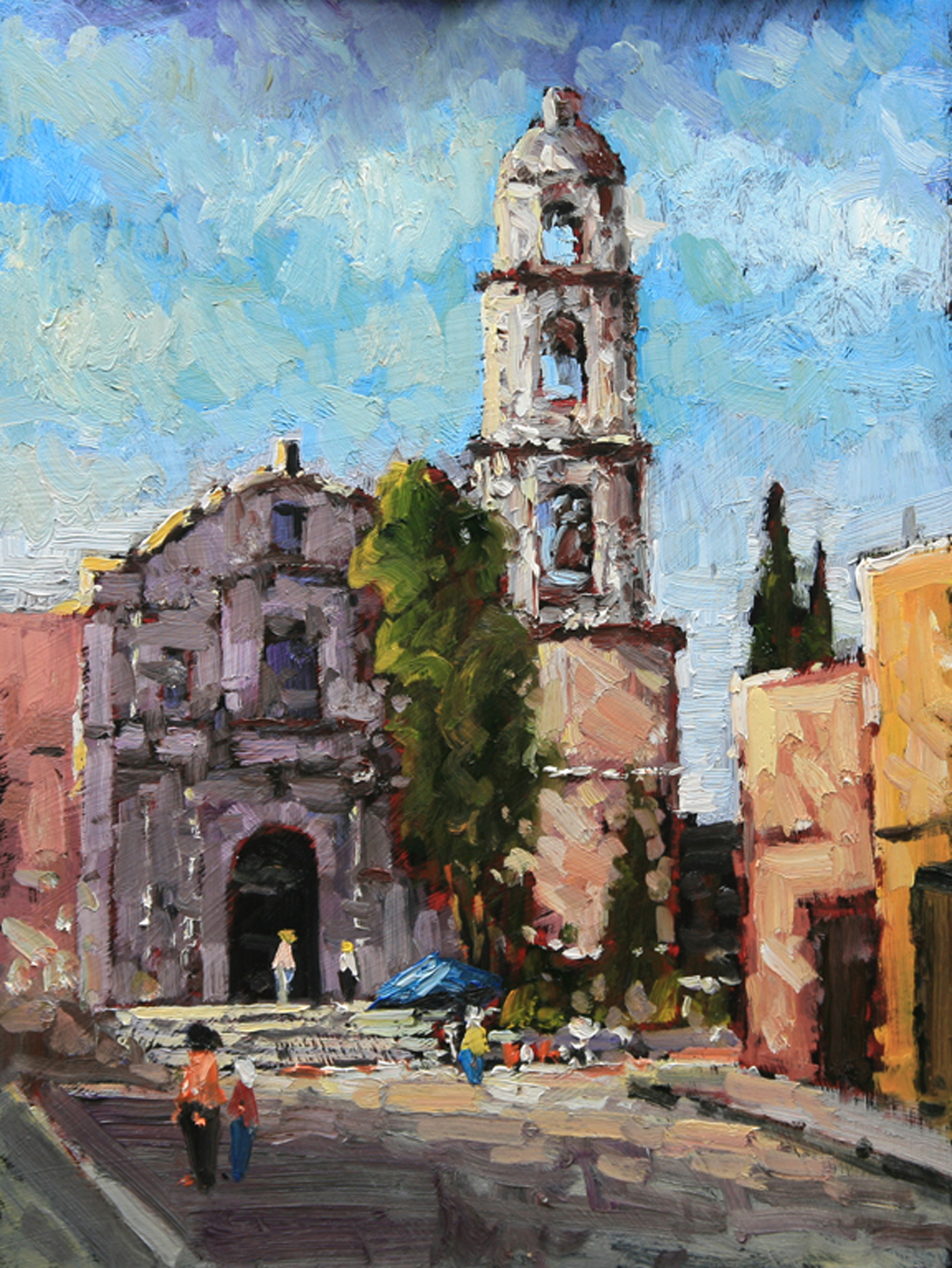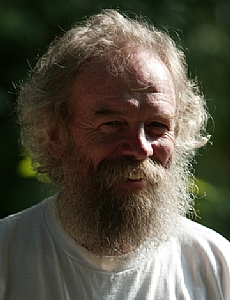Neil Patterson, President of Oil Painters of America,
will provide a Q and A session on Wednesday, October 13.
All OPA Eastern Regional Exhibition paintings will be available for sale at
the Opening of the show on Friday, Oct. 15.

Neil Patterson – “San Miguel”, 16 x 12, oil
“Painting is all about passion,” declares Neil Patterson. “If you respond to the passion that you have inside yourself, that’s when the real painting comes out. Selling your work is a bonus; painting itself is what really matters.” It is his ability to paint feelings rather than merely replicating what he sees that makes Patterson’s vibrant, impressionistic oils so appealing.
 Born and raised in Moose Jaw, Saskatchewan Patterson has always wanted to become an artist. His mother encouraged him as a young child, saying, “You can have whatever you want. If you want it enough, you’ll get it.” However, there were no galleries in the tiny Canadian community, so young Patterson had little exposure to original works until he visited his aunt in Ottawa when he was 12. She took him to the National Art Gallery where his burning desire to become an artist was rekindled. Young Patterson bought a book titled How to Paint and remembers reading it on the train back to Moose Jaw.
Born and raised in Moose Jaw, Saskatchewan Patterson has always wanted to become an artist. His mother encouraged him as a young child, saying, “You can have whatever you want. If you want it enough, you’ll get it.” However, there were no galleries in the tiny Canadian community, so young Patterson had little exposure to original works until he visited his aunt in Ottawa when he was 12. She took him to the National Art Gallery where his burning desire to become an artist was rekindled. Young Patterson bought a book titled How to Paint and remembers reading it on the train back to Moose Jaw.
“I didn’t have any paints and our school didn’t have an art department,” confesses Patterson. Nevertheless, on his 13th birthday, his aunt sent him a set of oils and his career began. Poking around in the basement for something to work on, he found a heavy industrial-grade canvas belt and commandeered it for his first painting. “I still have some of my earliest paintings,” states Patterson, matter-of-factly. “I keep them as a reminder of where I started. All artists start in the same place. I don’t think there’s such a thing as talent; it’s more desire than anything. You could teach anybody to paint competently, if they really wanted to learn. After that it’s just a little something of yourself, call it soul, that has to go into the painting, and I think that comes with hard work, experience and age.”
Patterson’s road to success resembled less a superhighway than a rocky trail. Patterson worked for several years as an architectural draftsman, running his own drafting company for a while. Still, his fascination for painting remained and he enrolled in the University of Calgary Fine Arts program. Here events took an unexpected turn. Disappointed with what he saw as a lack of practical instruction, Patterson switched to the ceramics department, which offered more opportunity for hands-on learning. “In all my years at university. I never saw a professor use a brush,” he says.
After university, he took over a downtown pottery studio from an artist who was moving east. “I had no running water, but the roof leaked, so I collected rainwater,” he laughs. Throwing pots almost daily, his pottery business thrived. In 1976 he moved his business to the Bragg Creek area where he continued to make pottery, paint, and run a successful art gallery.
One day, however, he was forced to acknowledge that his body was paying a stiff price for the repetitive nature of his work with ceramics. First came wrist surgery for carpal tunnel syndrome, then ultimately a diagnosis of chronic tendonitis. “The doctor told me to stop what I was doing or lose the use of my hands,” confides Patterson. “When I gave up making pots, I decided to devote all my time to painting.” Actually, he sees similarities between the two mediums. “Painting is much like making pots. You play with the clay and I guess I’ve approached painting the same way. I like to be the creator, and put spots of colour on the canvas. I just play with the colours until they represent something,” he says.
In 1985 Patterson married and his wife, Vera, who took over supporting the family while Neil painted and cared for their two young sons: Jonathan and Sean. “I built them little easels, and they painted right along with me in the studio,” he chuckles. Oddly enough that stay-at-home lifestyle became one of the strongest factors in shaping Patterson’s future painting technique. Worried about the long term effects that turpentine might have on his sons’ health, he began to paint straight from the tube, mixing the pigments directly on the canvas and allowing their thick, peanut-butter-like consistency to guide his brush in creating the bold, sweeping strokes and texture that have become his hallmark. Applied thickly, the paint leaves grooves that create areas of light and shadow achieving a textured effect so three-dimensional that the paint actually creates its own shadows. “One positive aspect of this technique,” Patterson says, “Is that one painting can become 50 paintings, depending on the light.”
Always willing to pass on his distinctive approach to oils, Patterson also takes great joy in teaching workshops. “Many instructors don’t want to share their secrets, but I believe in giving everything when I teach, because no one else can apply the paint exactly like I do,” he states. “I’ve found that even I can’t reproduce it exactly a second time. This is because I let the painting talk to me as I work. If your mind is full of your own plans for it, you won’t hear what it has to say or what it wants. You have to learn to give in. If the painting wants a pink sky, give the painting a pink sky. What holds the artist back is fear; fear of not doing a good painting; fear and a lack of confidence. If you come to the painting with a plan, then you will miss out on the ‘happy accidents.’ You will get caught in your own web of details and those ‘happy accidents’ don’t have a chance.” In his workshops, his methods often confound the painter who is used to a well thought out idea and a well-planned palette. “If you come with a preconceived idea you will be disappointed if you don’t produce what’s in the mind’s eye,” he explains. “You must be free in order to allow the painting itself to lead your thoughts.”
Inherent in his painting is the belief that a work of art must be more than a reproduction. “Why try to reproduce nature?” he asks. “It can’t be done. For instance, if you put a rose in the sun, even a painting by the most professional rose painter in the world would not begin to convey the beauty of the real flower. It just can’t be done. A painting is only pigment – a representation of the real thing. You cannot compare the painting of a rose with the reality of the rose itself. A painting is simply an impression of reality.”
Patterson emphasizes that colour, not subject, is the true essence of his paintings. Not limited to a single genre, he moves from landscapes to floral works to wildlife paintings and figures with an easy grace. Patterson relies on an impressionistic Alla Prima style. “I used to work from photographs, but over the years I’ve learned not to do that,” he says. “When I see a sky, I like to put that in my visual memory bank, and on another day I might add an appealing cluster of trees or an intriguing bend in the river. As I paint I simply add a mountain or plant a tree in order to create a scene that pleases me visually. The final composition becomes a composite of many impressions in my memory. Each of us remembers things in a certain way that is our own reality. I paint things the way I remember them, perhaps not exactly as they are.”
Elected to membership in the prestigious group of intellectuals and artists known as the Salmagundi Club of New York, Patterson is also the first Canadian to become a signature member of Oil Painters of America and to attain the status of OPA Master Signature Member. Patterson also holds memberships in the Rocky Mountain Plein Air Painters, the Tucson Plein Air Painters, and the Laguna Plein Air Painters Association. As a board member of the OPA since 2002, Patterson has served as Co-Chair of Exhibitions, Juror of Awards, and Signature Advisory Board Chair. In 2006 he was elected Vice President of OPA.
Patterson has numerous awards to his credit and has been published in many books, newspapers and magazines including The Best of Flower Painting, International Artist Magazine, Art of the West and The Artist’s Magazine. His bright impressionistic scenes have found enthusiastic audiences in Canada, the United States, and most recently in China.
Upon traveling through China with world-renowned artist Zhiwei Tu, Patterson’s work earned many accolades and can be found in the collections of the Shaoguan and Wengyuen Museums. Patterson’s work is currently touring China, as part of a contemporary art show entitled Out West: The Great American Landscapes. After its Beijing premiere at the National Art Museum of China in March 2007, the exhibition will tour the Xingjiang Academy of Art and Xingjiang Society of Oil Painting, the Art Museum of Shanxi Province, the Art Museum of Shanghai and Shanghai Academy of Chinese Painting, Qingdou Branch of the National Art Museum of China, Guangzhou, and Hong Kong through September 2007.
As he looks back over his career, Patterson emphasizes that becoming a successful painter is a lifetime endeavor. “It’s all those experiences, good and bad, that are translated into what you paint,” he says. “ If you paint with passion, with joy, with the innocent playfulness of a child, and feel shivers run down your back as you work, that is the real reward.”
